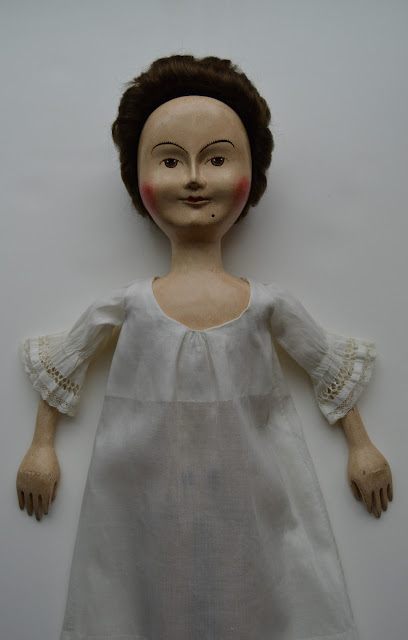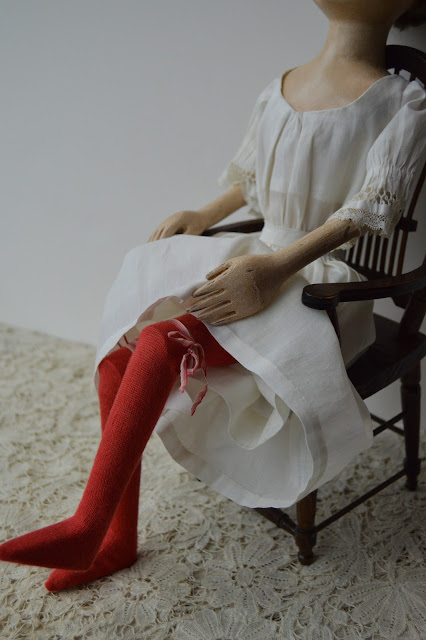You may be familiar with this enchanting face!
This lovely lady is inspired by a late 17th century pandora doll. In the past decades some dolls with similar facial and body complexions have been found in England, a fine example of these spectacular dolls are Lord and Lady Clapham at the Victoria & Albert Museum. These early dolls were finely made, the painting and finish are exceptional. Makes me think if they were made by the same craftsman? Something for sure is that these dolls were made for the wealthy people and were dressed in the latest fashion of the time.
My doll is 18" tall, I custom made her clothing and accessories with early materials and textiles, some of them dating back to 1790. I have posted several photos for you to see step-by-step how I have dressed her and all the details of this doll. Enjoy!
SOLD
Here is a photo of her entire wardrobe
Her body is made of wood except for her cloth upper arms. A large head and large hands are two distinguished characteristics of these early dolls.
As you know, Pandora dolls travelled all over Europe (they also arrived in America by the mid to late 1700's). They represented the latest trends in fashion, they didn't only display the newest fashion dress, layers of petticoats and luxury fabrics but also accessories, jewelry, shoes and of course the latest hairstyles. I imagine the care that these makers put to ship out these works of art to make sure these pandora dolls arrived safe and sound, which means that the delicate wooden bodies wouldn't break, the luxurious textiles arrived without deep creases or wrinkles and the elaborate wigs wouldn't lose their shape!
Wigs were made with human hair or mohair. Unfortunately, most of these dolls that have survived till now, have suffered the ravages of time and they retain just a wisp of hair beneath a head-dress or bonnet. With or without hair, they are gorgeous either way, these dolls are beautiful art pieces to treasure. " Time bestowed them beauty "
My doll is wearing a period accurate wig with a high-front style; it's made from antique English mohair in a lovely brunette color.
The shift is considered the most basic garment of the 18th century woman's wardrobe. It plays an essential role because not only does it protect her clothing from the body moisture, but also will protect her from the roughness of some elaborate textiles, some of them were composed entirely of metal threads, like the stays that I made for her.
Dickey petticoat: It is a second layer of skirt worn for modesty and to add warmth to the dress during the cold weather.
I just love her stockings! Made of soft cotton in the loveliest crimson shade of red color. These were repurposed from a pair of stockings from the Victorian Era.
Dainty antique French silk ribbons are tied tightly around her legs, just above the knees to hold up the stockings. This beautiful diminutive silk ribbon was made for AU BON MARCHE Department Store in Paris, France around 1890.
Stays: Late 19th century Turkish gold metallic embroidery.
I made a teeny-tiny needle to lace her stays.
False rumps were usually stuffed with cork, feathers, cotton, horsehair. Most of them have attached a cotton or linen panel to protect her from the roughness of these materials, so clever!
I love to repurpose antique garments or remnants of textiles that were made long time ago. As a textile collector I love to study and preserve them and because antique textiles are unique, I always envision for each of them the opportunity to be restored or recycled. With care and imagination, it's a great feeling to know that these fabrics won't reach the end of their lifecycle when I reuse them for my doll's clothing.
"Point de Beauvais needlework"
Linked-stitch Embroidery: This type of embroidery was made by hand and is known as "Point de Beauvais needlework". It's Italian in origin and dates back to the middle-ages. During the 1700's it became very popular in France.
My doll's cloth pockets are made of a rare, beautiful example of Point de Beauvais textile fragment that was once part of a garment or decorative panel.
Her dress is made of a stunning silk brocade textile with silver metallic threads, probably French, 3rd quarter 18th Century
My doll is wearing a Historical Dress: The Robe a la FRANCAISE or also known as SACK-BACK Gown with matching stomacher and petticoat. It was the fashion dress of the entire 18th century, but became more popular during the years of 1760' to 1770's. It features a pleated back panel, open front with a slight train.
" Sweet Bags of the 16th and 17th Centuries"
These small purses were popular during the centuries described above. The sweet bag was filled with spices, dried flowers and herbs, scented powders with the purpose to perfume their bodies and clothing. Most of these bags were beautifully made with intricate embroideries.
Her sweet bag is made with a Beauvais embroidery and gold metallic tassels that date from around 1790's
This antique French ribbon rosette is dainty and precise for her head-dress
Her necklace is made of glass seed beads and a tiny
gold-filled watch slide from the Victorian Era
Shoes: 19th century Ottoman embroidery with metallic threads


























No comments:
Post a Comment